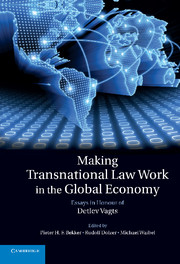Book contents
- Frontmatter
- Contents
- List of contributors
- Foreword: the transnationalism of Detlev Vagts
- List of cases cited
- List of abbreviations and acronyms
- Introduction: a Festschrift to celebrate Detlev Vagts' contributions to transnational law
- 1 Detlev Vagts and the Harvard Law School
- 2 Constructing and developing transnational law: the contribution of Detlev Vagts
- I International law in general
- 3 ‘Hegemonic international law’ in retrospect
- 4 Textual interpretation and (international) law reading: the myth of (in)determinacy and the genealogy of meaning
- 5 The changing role of the State in the globalising world economy
- 6 Sources of human rights obligations binding the UN Security Council
- 7 Is transnational law eclipsing international law?
- 8 Participation in the World Trade Organization and foreign direct investment: national or European Union competences
- 9 From dualism to pluralism: the relationship between international law, European law and domestic law
- 10 Transnational law comprises constitutional, administrative, criminal and quasi-private law
- 11 Founding myths, international law, and voting rights in the District of Columbia
- 12 The tormented relationship between international law and EU law
- 13 International law scholarship in times of dictatorship and democracy: exemplified by the life and work of Wilhelm Wengler
- II Transnational economic law
- III Transnational lawyering and dispute resolution
- Bibliography of Detlev Vagts
- Index
6 - Sources of human rights obligations binding the UN Security Council
from I - International law in general
Published online by Cambridge University Press: 17 November 2010
- Frontmatter
- Contents
- List of contributors
- Foreword: the transnationalism of Detlev Vagts
- List of cases cited
- List of abbreviations and acronyms
- Introduction: a Festschrift to celebrate Detlev Vagts' contributions to transnational law
- 1 Detlev Vagts and the Harvard Law School
- 2 Constructing and developing transnational law: the contribution of Detlev Vagts
- I International law in general
- 3 ‘Hegemonic international law’ in retrospect
- 4 Textual interpretation and (international) law reading: the myth of (in)determinacy and the genealogy of meaning
- 5 The changing role of the State in the globalising world economy
- 6 Sources of human rights obligations binding the UN Security Council
- 7 Is transnational law eclipsing international law?
- 8 Participation in the World Trade Organization and foreign direct investment: national or European Union competences
- 9 From dualism to pluralism: the relationship between international law, European law and domestic law
- 10 Transnational law comprises constitutional, administrative, criminal and quasi-private law
- 11 Founding myths, international law, and voting rights in the District of Columbia
- 12 The tormented relationship between international law and EU law
- 13 International law scholarship in times of dictatorship and democracy: exemplified by the life and work of Wilhelm Wengler
- II Transnational economic law
- III Transnational lawyering and dispute resolution
- Bibliography of Detlev Vagts
- Index
Summary
Introduction
Since the collapse of the Soviet Union and the end of the Cold War, the Security Council of the United Nations has intensified its work in a way unimaginable in the long period of bipolar stalemate that had begun only a few years after the founding of the United Nations and lasted for some forty years. Lifted up by a wave of post-Cold War enthusiasm, the Council both greatly increased its efforts in its ‘traditional’ area of responsibility – the maintenance of inter-state peace and security – and expanded its mandate to new fields and issues, among them the fight against global terrorism, democratisation and the protection of human rights. In the meantime, the enthusiasm of the 1990s with its perhaps exaggerated hopes subsided, but the new powers claimed by the Council in the last fifteen years have not been called into question. On the contrary, and somewhat astonishingly, these powers have been generally accepted by the members of the international community, and are awaiting new situations in which the Council will use them.
As a consequence of the sharply growing activities of the Council, a discussion has arisen regarding the scope, and possible sources, of the Council's international legal obligations. Is the Council, when discharging its responsibility under the UN Charter, bound by rules of international law, and if so, by which rules exactly? In particular, the issue of the Council's human rights commitments has attracted a great deal of interest.
- Type
- Chapter
- Information
- Making Transnational Law Work in the Global EconomyEssays in Honour of Detlev Vagts, pp. 71 - 92Publisher: Cambridge University PressPrint publication year: 2010
- 1
- Cited by



